Rugs can sometimes be forgotten when they make up part of a room. These well-trodden carpets can take on constant use and strain, beyond what we would expect of any other antique or contemporary piece of art. However, the high value of such items is unlikely to be ignored, as these specialist textiles can fetch high prices at auction and in retail spaces.
 Above: a selection of Persian rugs with various patterns and colours
Above: a selection of Persian rugs with various patterns and colours
Although valuable rugs can be insured for drastic damage, it is recommended that care is provided to them in order to prevent long lasting deterioration and loss. In this article we will discuss the ways in which you can care for both antique and modern day carpets, including the risks which these unique artworks may face in their lifetime.
 Above: constant use of a rug, such as walking on it with outdoor shoes, may accelerate deterioration
Above: constant use of a rug, such as walking on it with outdoor shoes, may accelerate deterioration
Many risks face rugs, whether they are in a private home or public space. Whilst the fabric itself may wear down over time through constant footfall, even the avoidance of constant use will not prevent the wider issues facing these textiles. Many risks come from accidental damage, whether this is through an escape of water or unsupervised pets. However, environmental factors may also affect the longevity of its structure and these can be more easily controlled.
Rug genres and styles
A wide variety of rugs come to our specialist conservators at the Fine Art Restoration Company. Within this genre of textile, you will find many styles including:
- Traditional Victorian Rugs
- Kilim Rugs
- Moroccan Rugs
- Persian Rugs
- Dhurrie Rugs
- Natural Fibre Rugs
- Ikat Rugs
- Overdyed Rugs
- Area Rugs
- Hallway Rugs
- Shag Rugs
- Historic Rugs (For Display Only)
- Mid-Century Modern Rugs
- Contemporary Rugs
 Above: a selection of handmade hooked rugs made in the United States, 19th century
Above: a selection of handmade hooked rugs made in the United States, 19th century
Atmosphere
UV rays can have a negative effect particularly on natural dyes, causing them to change colour and fade over a course of time. Modern dyes may also be susceptible, and sometimes just one colour out of a dozen can begin to distort, leaving the intricate or bold pattern lacking it’s original impact. For instance, red is known to fade at a faster rate than blue.
 Above: a rug in a conservatory room – strong sunlight and high humidity may severely damage a rug to the point of decay
Above: a rug in a conservatory room – strong sunlight and high humidity may severely damage a rug to the point of decay
To avoid this, ensure that the rug is kept out of direct sunlight, or place UV protective filters on the windows for maximum effect. If a rug is mounted and framed, it is also possible to place this behind UV protective glass. Our framing specialists offer 70-99% protection with museum quality options.
Mould and dry rot
Controlling the humidity and temperature is key in avoiding the issues which can be compelled by moisture and spores. Mould and mildew are the first two stages of a fungus which is attracted to the fibres of the carpet. Whilst these can be professionally treated, allowing the rug to return closely to its original state, the third phase known as ‘dry rot’ will be a lot harder to contain. Dry rot appears as the rug literally rotting away, with pieces falling off and the overall structure left in an unstable state. This is why it is important to stop any mould in its tracks, as when it is left, the effects can be devastating.
 Above: a severely damaged prayer rug with holes and deterioration due to age and atmospheric conditions
Above: a severely damaged prayer rug with holes and deterioration due to age and atmospheric conditions
Mould usually stems from water damage, but can also be caused by high levels of humidity. It is recommended that a rug is kept at a humidity level which is no higher than 65%, with a perfect condition of 40-50%. Leaving the air too dry may cause a brittle texture, so an even level is important.
If you spot mould or mildew in a rug or textile of any kind, contact our team as soon as possible for preventative measures and a full restoration which will remove these dangerous spores.
Water damage
Water damage regularly occurs through accidental spills, as well as more devastating escapes of water such as a flood or leak. As well as posing a risk from mould growth, water damage may also disrupt the colours of the rug.
 Above: a water damaged Persian rug which has bleeding dyes causing widespread distortion
Above: a water damaged Persian rug which has bleeding dyes causing widespread distortion
Dyes may begin to bleed, especially where there is a particularly light area next to dark tones. Some colours, such as red, may be more likely to bleed than others, depending on their age and original chemical composition. In the manufacturing process, some rugs may have been over-dyed, this means that there is a heavy amount of colour in the fibres which can be easily moved around as a dry dust or by means of water.
You can read more here about the restoration of a water damaged Persian rug.
 Above: a detail from the water damaged rug before our team performed restoration treatments
Above: a detail from the water damaged rug before our team performed restoration treatments
Sometimes water damage may occur due to household cleaning techniques, for instance an amateur attempt to clean a stain or the entire rug with soap and water. This untrained washing technique may produce more damage than it was originally intending to remove.
If a rug meets a small amount of water, ensure that this dries naturally and that there is no residue dwelling within the fibres. Even the slightest amount of moisture can attract mould and the beginnings of dry rot. If there is a large amount of water damage, evidence of trapped moisture or bleeding of dyes, contact our team straight away for professional removal of the rug and specialist treatments. Do not immediately roll a wet rug as this may cause the bleeding to worsen or spread. Also avoid the use of industrial drying units, as the extreme heat may cause further damage, including a buckling of the structure.
 Above: the same water damaged rug following restoration by our team, the colours restored and professionally dried
Above: the same water damaged rug following restoration by our team, the colours restored and professionally dried
Pets and houseplants
Dogs and cats often cause accidental damage through the scratching of fibres, as well as chew marks in some cases. The most troubling issue comes from stains left by pet urine, which can cause permanent damage. Animal urine starts off as acidic and later becomes alkaline, this adversely affects the stability of the dye, making even colourfast rugs begin to bleed as the urine breaks them down. Urine should be soaked up the instant it is spotted, if it is left or is a frequent issue, contact our team. For preventative treatment, keep the rug in a pet-free location or place it beneath a protector. Furthermore, you should consider speaking to a veterinarian, as frequent urination outside of a litter box or designated area (such as outdoors) may be a sign of an underlying health condition in your pet.
 Above: a cat lying on a rug – cats may scratch carpets or shed fur which becomes embedded into the fibres over time
Above: a cat lying on a rug – cats may scratch carpets or shed fur which becomes embedded into the fibres over time
Houseplants are another cause for concern, as watering them brings a large amount of liquid into close contact with the carpet beneath them. Whilst some plants may have a pot or tray to prevent water from escaping, some may still overflow or dripping may occur following this. Similarly, mist sprays for tropical plants may land on nearby textiles. Small spillages may build up over a long period of time, trapping moisture deep within the rug.
 Above: plants which are located on top of or next to a rug may become a problem as moisture can be absorbed into the fibres over time
Above: plants which are located on top of or next to a rug may become a problem as moisture can be absorbed into the fibres over time
Blotting up these spills might not immediately solve the problem, as the fibres running all of the way along the piece are extremely absorbent and even a rug which feels dry may have water in it’s centre. Whilst this happening just once or twice may not be a massive threat, it is the repeated action of watering the plants in the same location which allows this moisture damage to build up out of sight, until mould and rot arrive. The best advice in this scenario is to keep houseplants away from rugs, as the risk of ongoing damage is very high.
 Above: a dog sitting on a rug – untrained dogs may chew or scratch rugs and bring contamination in from outside
Above: a dog sitting on a rug – untrained dogs may chew or scratch rugs and bring contamination in from outside
Moths and bugs
Pests pose a huge risk to rugs, especially carpet beetles and moth larvae. Whilst this may cause an obvious dent in the top of a rug, pests may be occupying the underside of it too. Whilst this can lead to completely bald areas, some may simply seem worn down with the interior white threads showing through. If you spot a webbing on the rug, or any sign of insect life, contact our team as soon as possible for professional eradication.
 Above: a dense or wooly rug may be a perfect home for insects and pests as it provides a food source and shelter
Above: a dense or wooly rug may be a perfect home for insects and pests as it provides a food source and shelter
The rugs which are at highest risk of these pests are wool, as the insects feed on these fibres and leave the cotton. However, many bugs may decide to nibble at the fabric if a sweet drink or something they find attractive has been spilled upon it in the past. It is recommended that a rug is professionally cleaned on an annual basis, to avoid the build up of dirt and contaminants which may be attractive to all sorts of pests.
Fire and smoke
Whilst a disaster such as a household fire may be unavoidable, the damage from smoke can be controlled. Fireplace soot, as well as nicotine in the air, can build up in the fibres. These particles can be toxic and lead to deterioration over a period of time, so it is important that rugs in a room with a fireplace have a lot of ventilation, away from the fire, or to be safest not kept in such a room at all. Smoking cigarettes, pipes, or cigars should also be avoided around rugs, as not only will the nicotine damage the textiles, but ashes dropping accidentally may burn holes.
 Above: a fireplace next to a rug may contaminate the fibres over time, discolouring it with soot and smoke
Above: a fireplace next to a rug may contaminate the fibres over time, discolouring it with soot and smoke
Shedding and fraying
Whilst all rugs may shed when they are brand new, this should quickly cease to be a problem. If the shedding continues, it may be a manufacturing error or a cause for concern. It is recommended, if the rug is in a good enough condition, that a fibre protective coating is used. Otherwise, rugs with such an issue should be seldom walked upon and only vacuumed with a very gentle amount of suction. Where fraying occurs, do not touch the area and contact our team for professional textile conservation, which can halt the issue and possibly reinstate missing areas.
 Above: a late 18th century rug woven in Anatolia, showing signs of fraying at the top as the ends begin to deteriorate
Above: a late 18th century rug woven in Anatolia, showing signs of fraying at the top as the ends begin to deteriorate
Buckling
Some rugs may be seen to curl at their ends, or have a disturbing warp to their structure. This is often caused by their production process, whether they are manufactured mechanically or by hand. Rugs can be professionally flattened and straightened using specialist techniques, but this is not something which can be easily achieved at home. However, this risk can be avoided by not rolling the rug for a long period of time, avoiding heavy furniture being placed upon it, and drying it flat and naturally if any water damage occurs.
 Above: a contemporary rug in a modern setting – even new rugs may face deterioration from the environment or due to their manufacturing process
Above: a contemporary rug in a modern setting – even new rugs may face deterioration from the environment or due to their manufacturing process
White knots and freckles
White freckles appear most often in handmade rugs. During their creation the cotton underlay may be tied in certain points, producing a slightly thicker dot of this hidden material. Whilst these white knots are perfectly natural, their appearance can become more pronounced as the rug ages or if it is cleaned with harsh techniques. To avoid more obviously white freckles appearing, only have the rug cleaned by a trained conservator and not by everyday dry cleaners.
Some owners may push back these knots to the underside of the rug, so that they do not show as prominently through the colourful top fibres. However, this leaves the rug at high risk as these knots becoming untied will form a hole which can then expand. The safest, yet purely visual, removal of these white dots is through carefully dying these areas. This should be performed by a professional conservator, who will use conservation-grade dyes to avoid any damage caused by unsuitable chemicals and inks.
 Above: an antique rug with white knots, freckles and faded dyes
Above: an antique rug with white knots, freckles and faded dyes
Popular rug designers
There are famous names in the world of contemporary rugs. You may come across the following designers, makers and suppliers:
- Nanimarquina
- Ben Soleimani
- GAN
- Moooi
- Deirdre Dyson
- Dimore Studio
- Sera Helsinki
- Missoni Home
- The Rug Company Designer Editions
- Kvadarat
- Loomah
- Hossein Rezvani
- Brink & Campman
- Lilla Rugs
- Vanderhurd
- Larusi
- Luke Irwin
- Illulian
- Mae Engelgeer
 Above: an age-deteriorated carpet with a vase technique and overlapping cartouche design, handmade in Iran, 17th century
Above: an age-deteriorated carpet with a vase technique and overlapping cartouche design, handmade in Iran, 17th century
Everyday care for rugs
Rugs can be treated with a protective coating to avoid shedding and colour loss, however this is not a guaranteed safeguarding technique as issues may still occur. For everyday care, gentle measures should be taken when it comes to dusting and cleaning. Whilst it is important to keep your rug free of dust built up, it is important, particularly in antique rugs, to not overzealously hoover on a high setting. A light suction is important in not disturbing the weave of the rug.
 Above: a brightly coloured rug with detailed floral patterns
Above: a brightly coloured rug with detailed floral patterns
Do not attempt to clean a valuable rug with household cleaning products, all forms of moisture should be avoided. A rug can also be protected from contamination and wear with a plastic covering, but this should be checked with a conservator before use to ensure it will not trap humidity or cause any distortion to the fibres.
 Above: a new rug with light areas which may be at high risk of visual disturbance from staining
Above: a new rug with light areas which may be at high risk of visual disturbance from staining
Get in touch with our team
Contact our team if you have any concerns about a rug in your care. Our team of experts are always willing to offer advice and arrange tailored treatments for each rug which comes to them, whether these are antique or contemporary.
You can get in touch by emailing [email protected] or calling us on 0207 112 7576

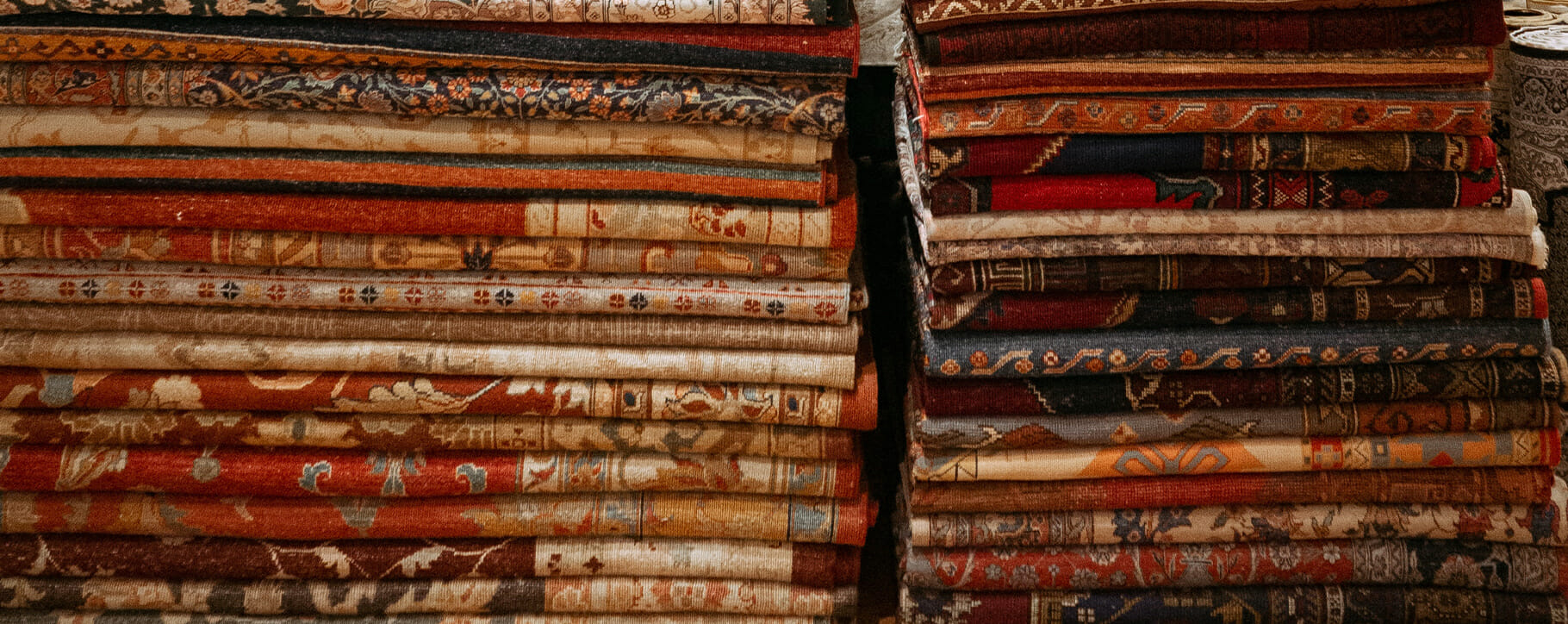 Above: a selection of Persian rugs with various patterns and colours
Above: a selection of Persian rugs with various patterns and colours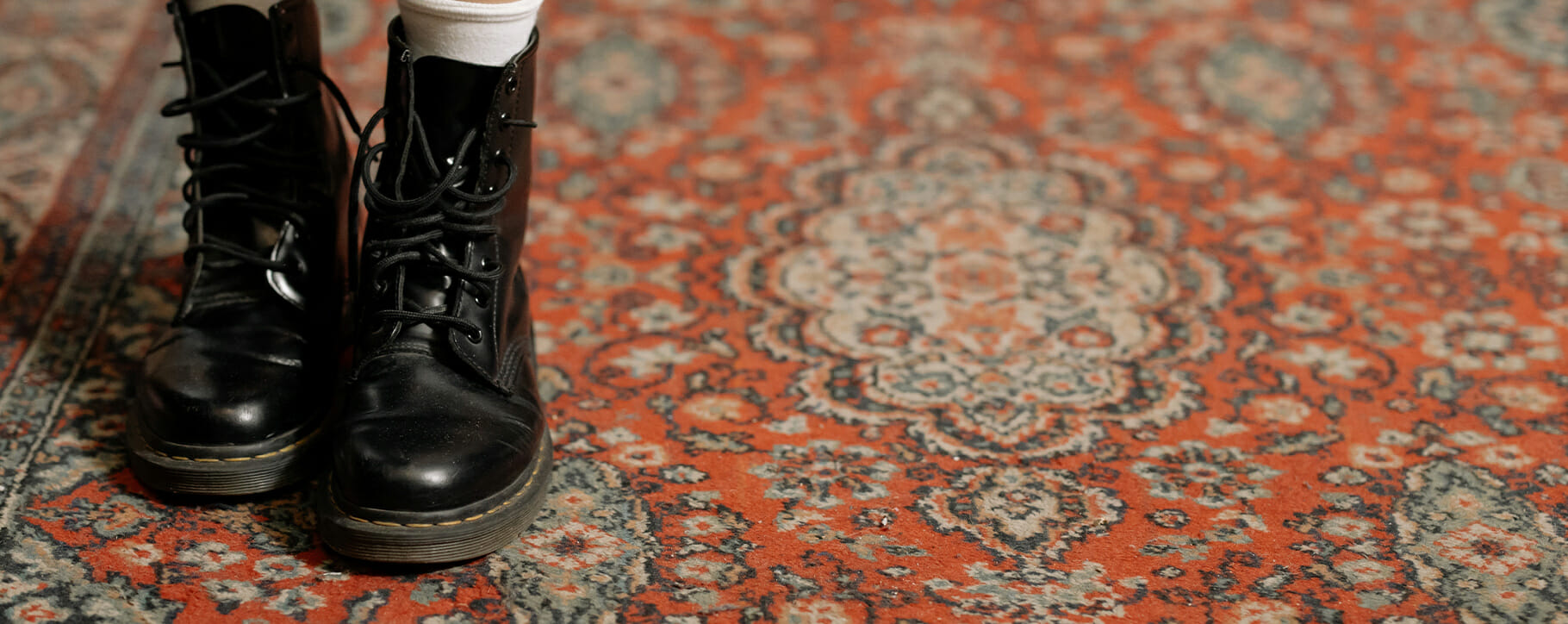 Above: constant use of a rug, such as walking on it with outdoor shoes, may accelerate deterioration
Above: constant use of a rug, such as walking on it with outdoor shoes, may accelerate deterioration 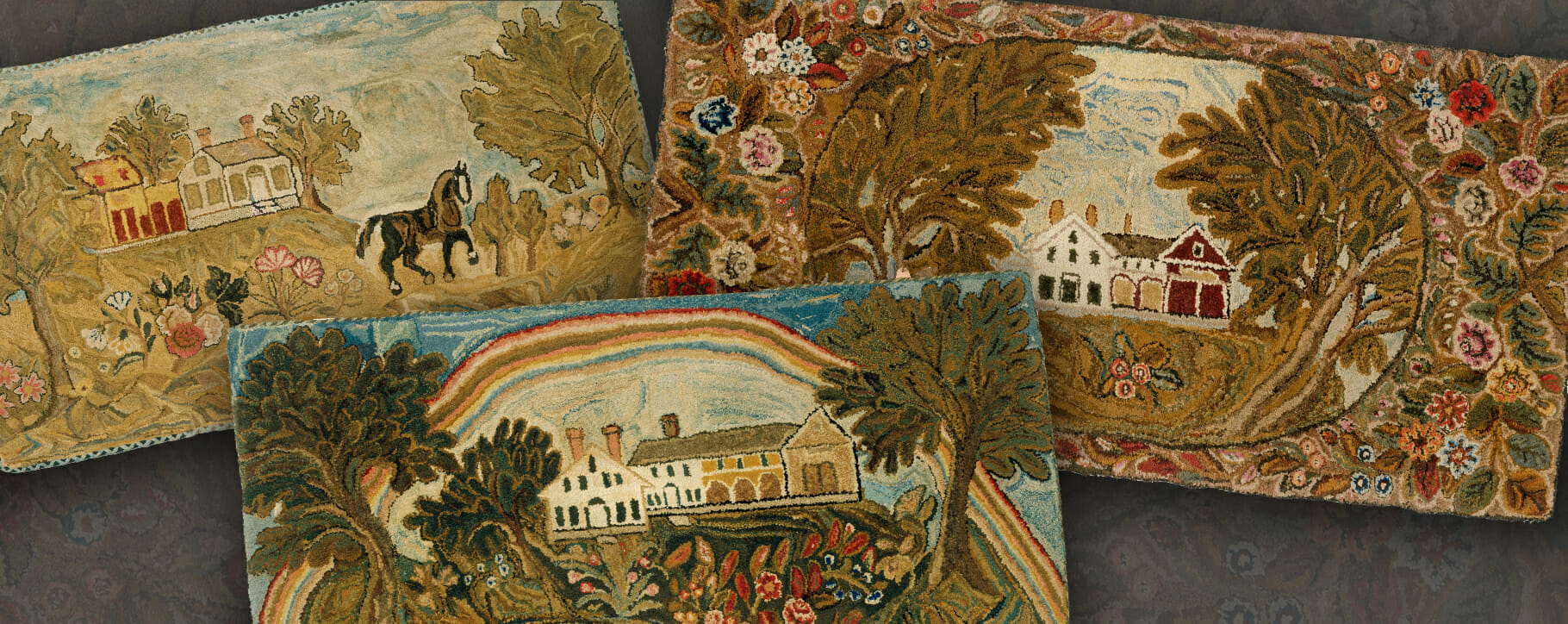 Above: a selection of handmade hooked rugs made in the United States, 19th century
Above: a selection of handmade hooked rugs made in the United States, 19th century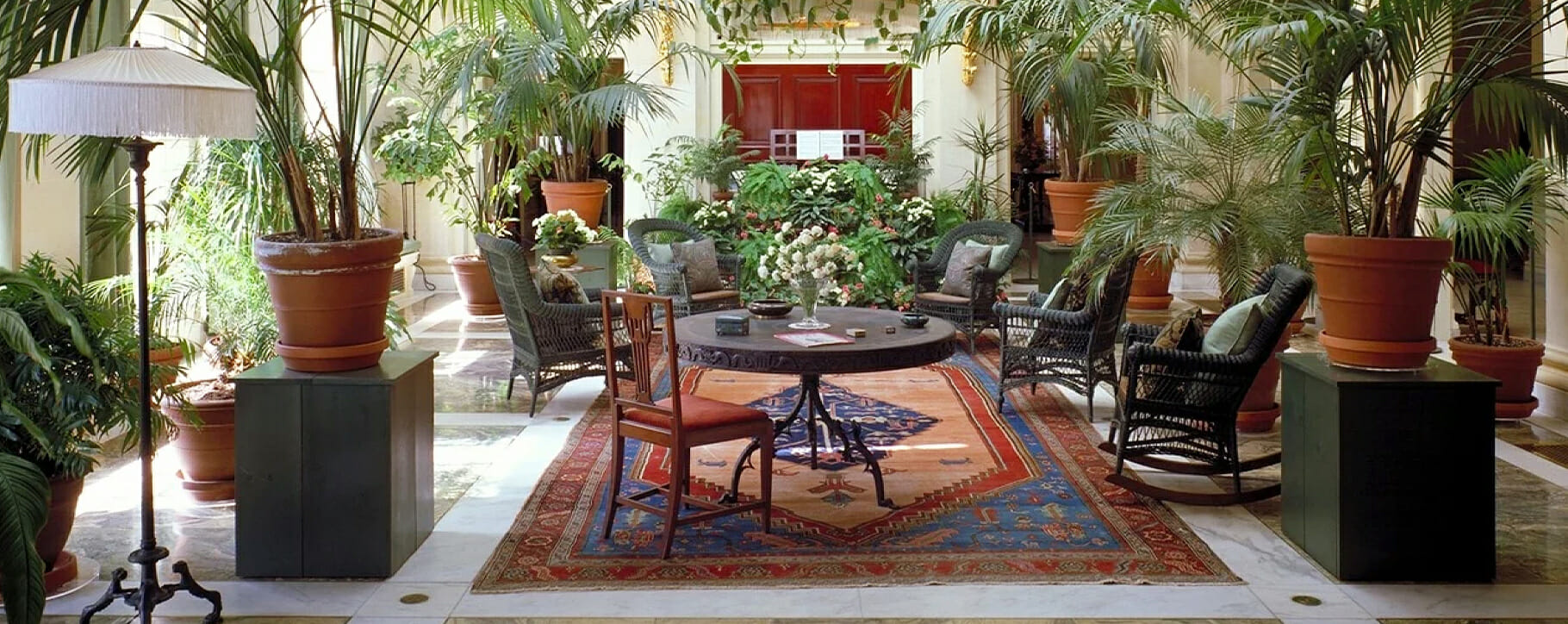 Above: a rug in a conservatory room – strong sunlight and high humidity may severely damage a rug to the point of decay
Above: a rug in a conservatory room – strong sunlight and high humidity may severely damage a rug to the point of decay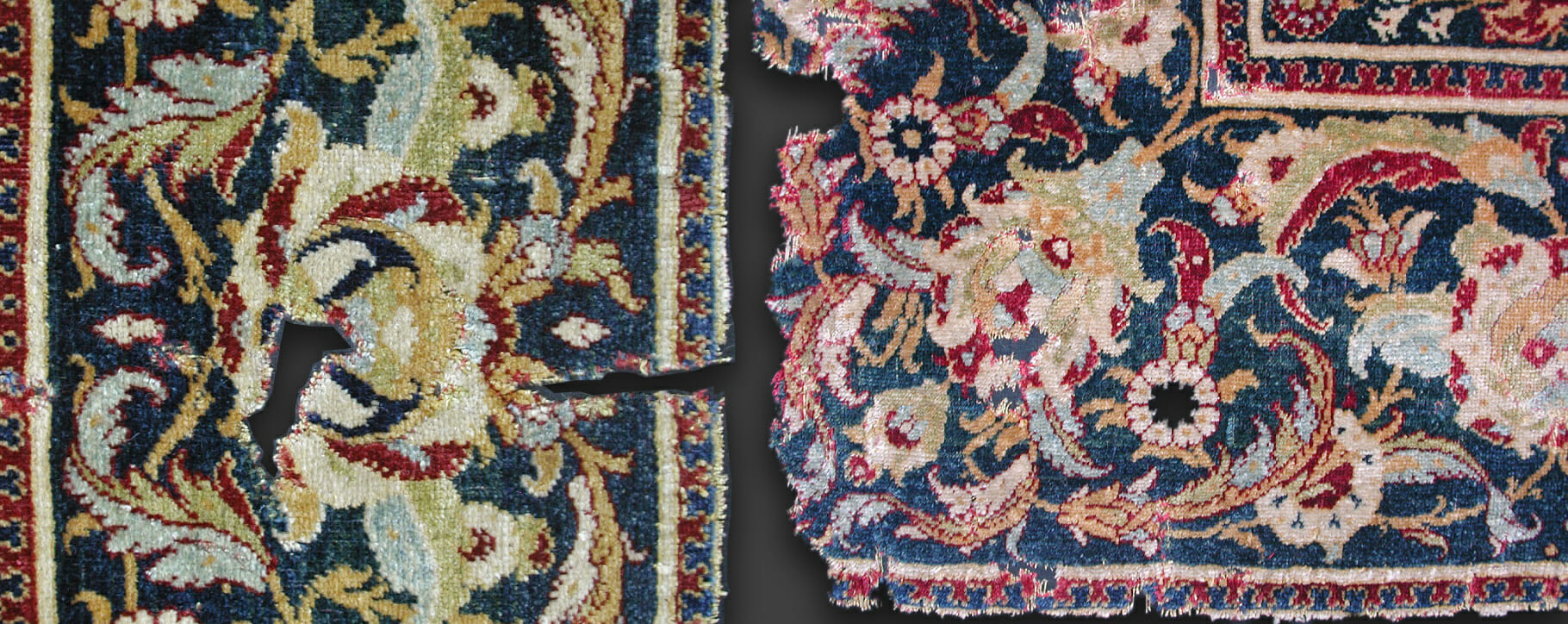 Above: a severely damaged prayer rug with holes and deterioration due to age and atmospheric conditions
Above: a severely damaged prayer rug with holes and deterioration due to age and atmospheric conditions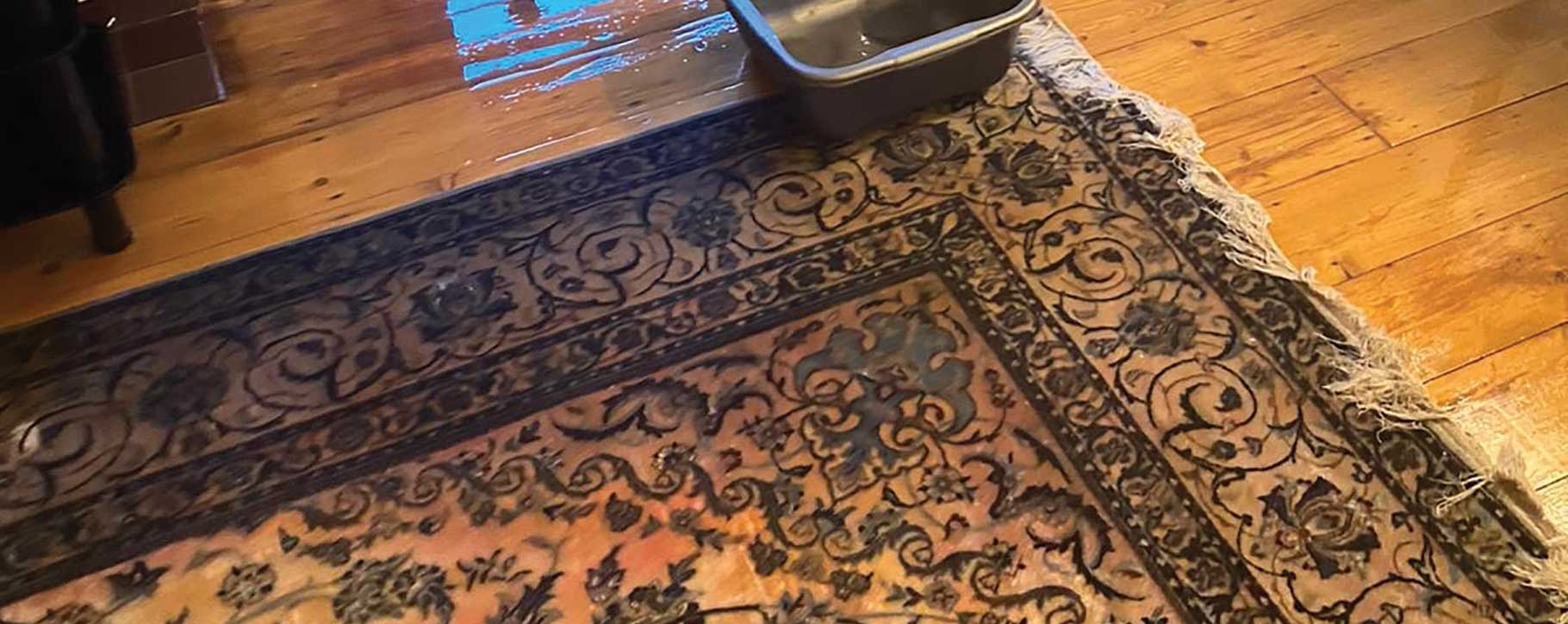 Above: a water damaged Persian rug which has bleeding dyes causing widespread distortion
Above: a water damaged Persian rug which has bleeding dyes causing widespread distortion Above: a detail from the water damaged rug before our team performed restoration treatments
Above: a detail from the water damaged rug before our team performed restoration treatments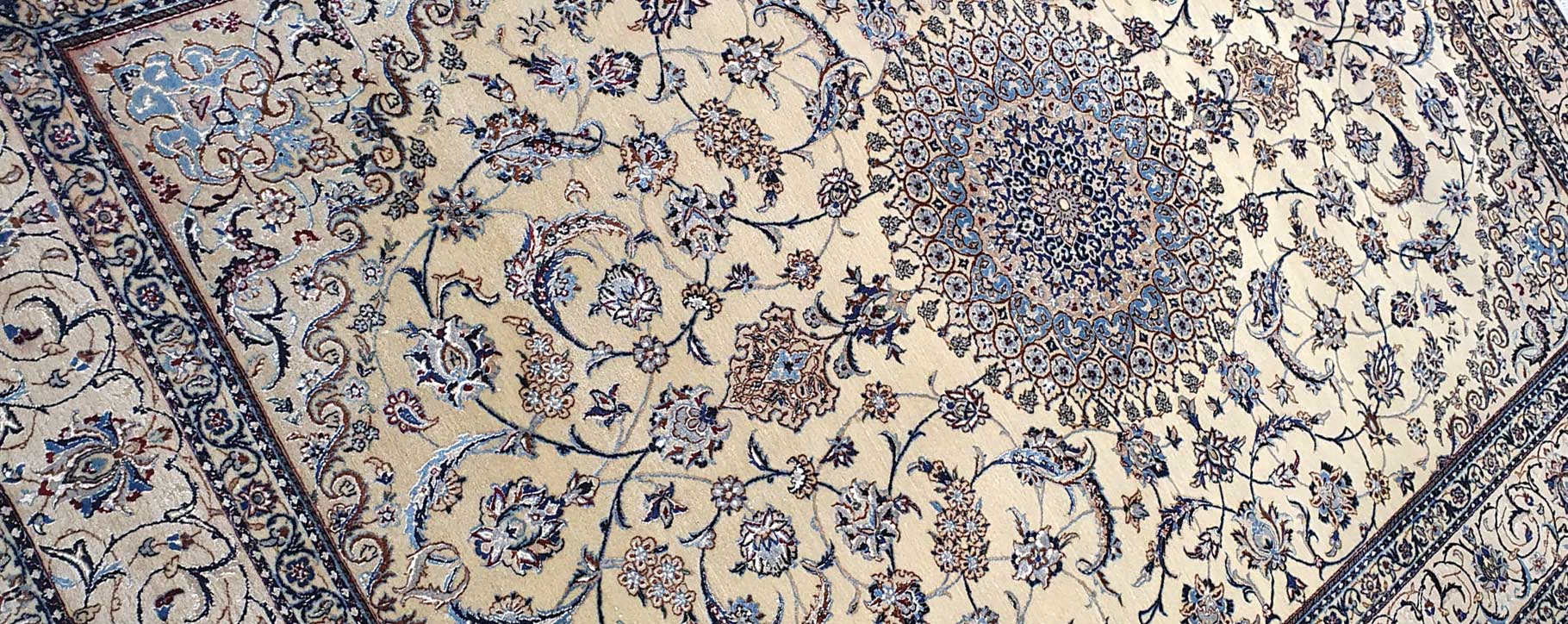 Above: the same water damaged rug following restoration by our team, the colours restored and professionally dried
Above: the same water damaged rug following restoration by our team, the colours restored and professionally dried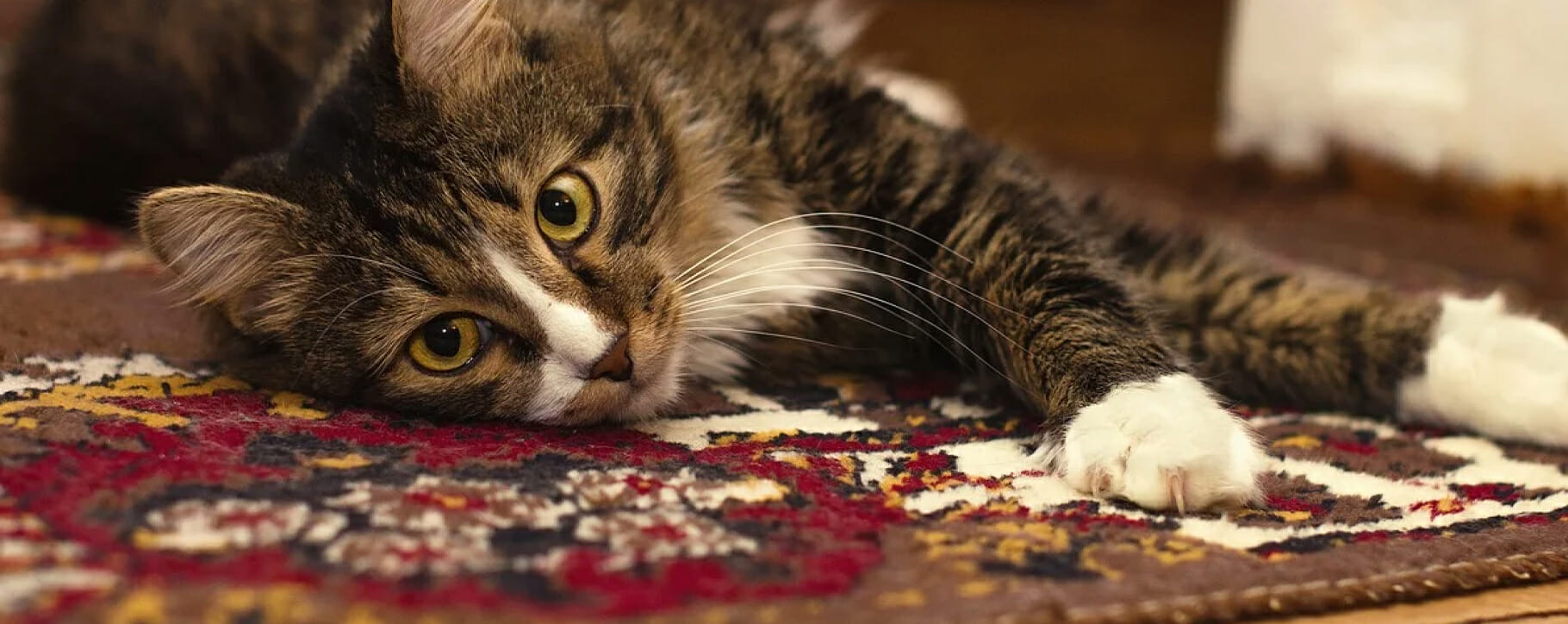 Above: a cat lying on a rug – cats may scratch carpets or shed fur which becomes embedded into the fibres over time
Above: a cat lying on a rug – cats may scratch carpets or shed fur which becomes embedded into the fibres over time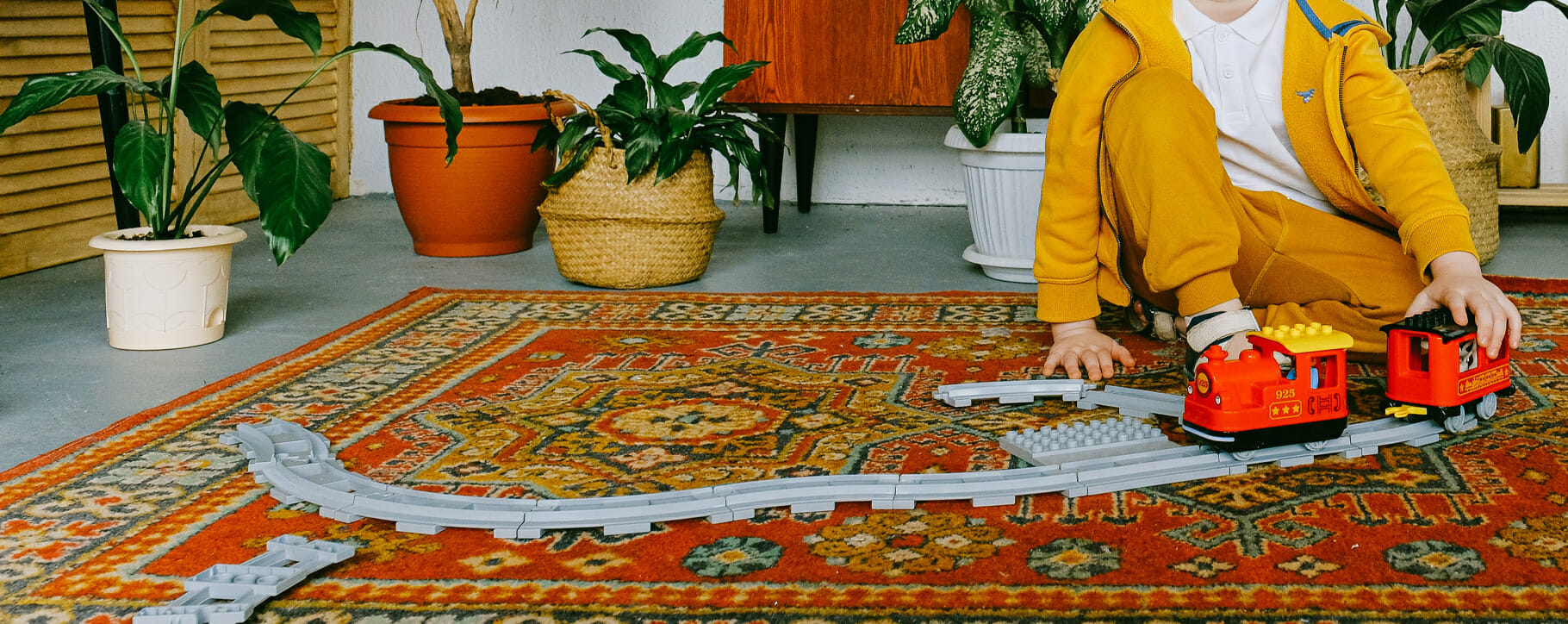 Above: plants which are located on top of or next to a rug may become a problem as moisture can be absorbed into the fibres over time
Above: plants which are located on top of or next to a rug may become a problem as moisture can be absorbed into the fibres over time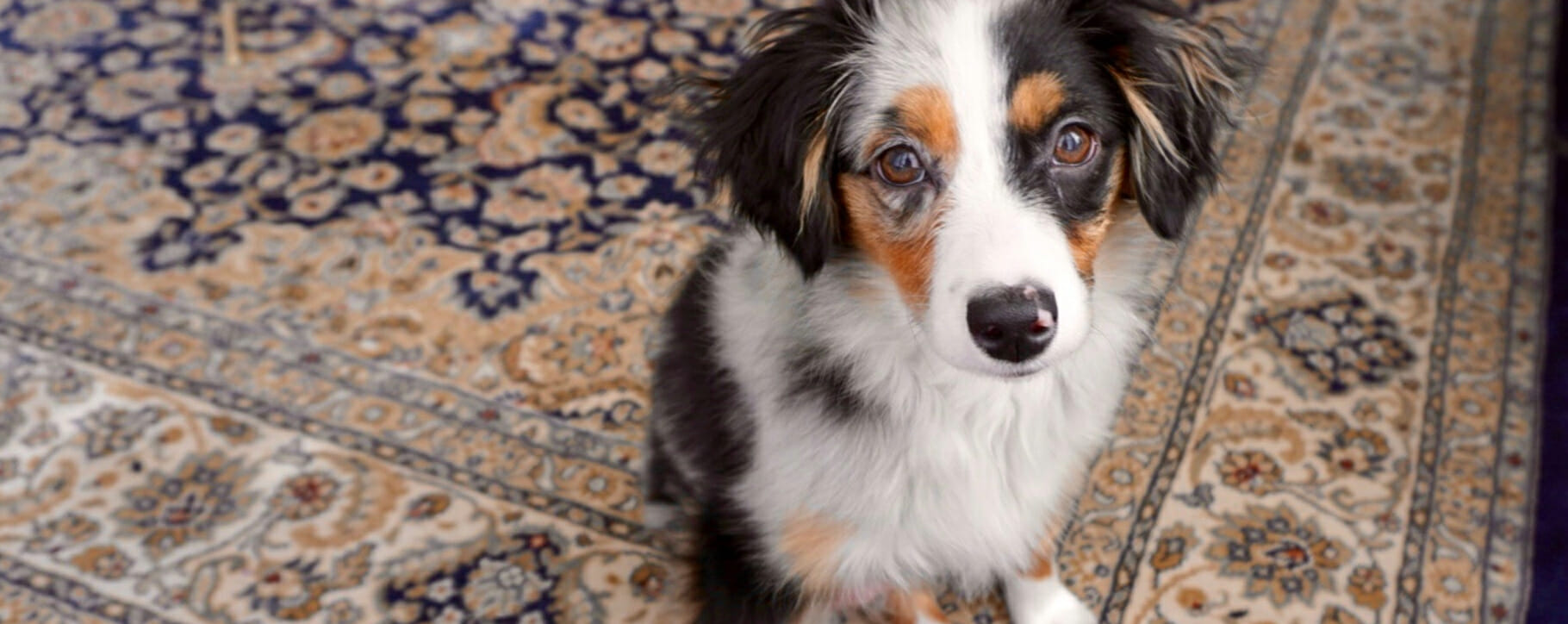 Above: a dog sitting on a rug – untrained dogs may chew or scratch rugs and bring contamination in from outside
Above: a dog sitting on a rug – untrained dogs may chew or scratch rugs and bring contamination in from outside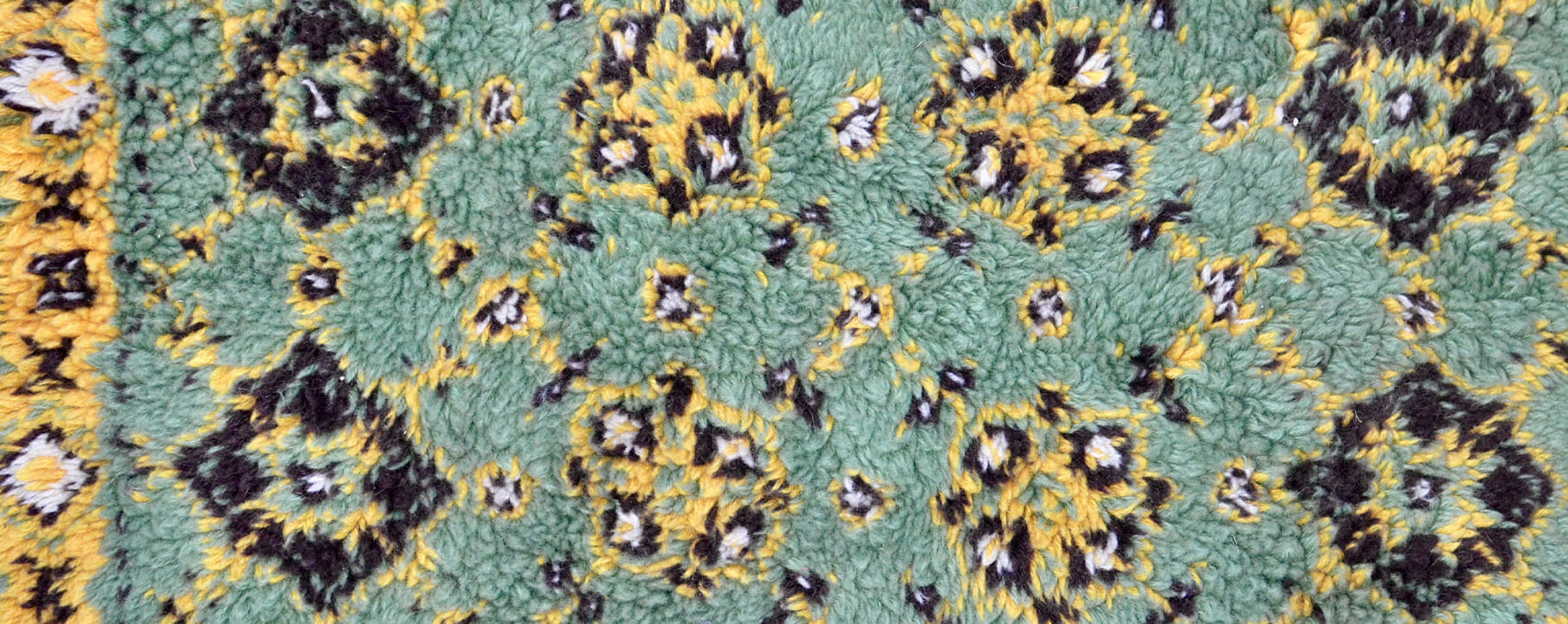 Above: a dense or wooly rug may be a perfect home for insects and pests as it provides a food source and shelter
Above: a dense or wooly rug may be a perfect home for insects and pests as it provides a food source and shelter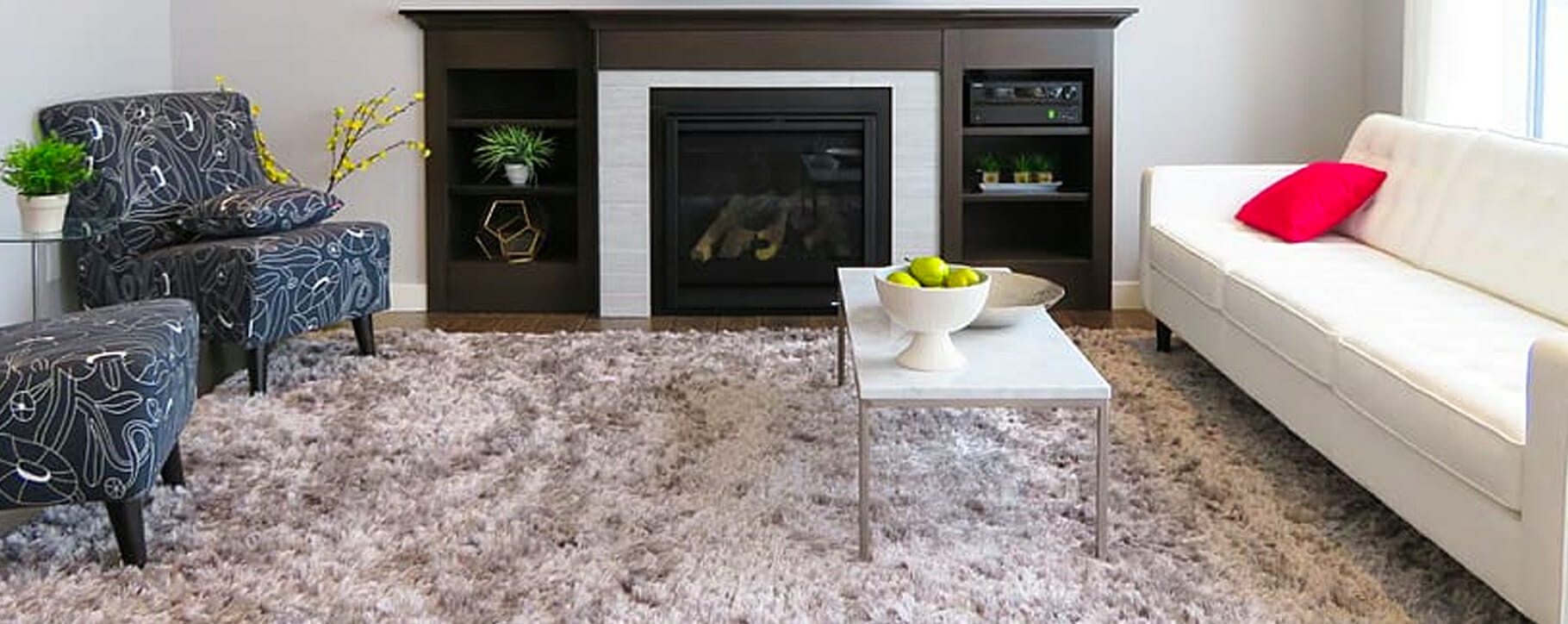 Above: a fireplace next to a rug may contaminate the fibres over time, discolouring it with soot and smoke
Above: a fireplace next to a rug may contaminate the fibres over time, discolouring it with soot and smoke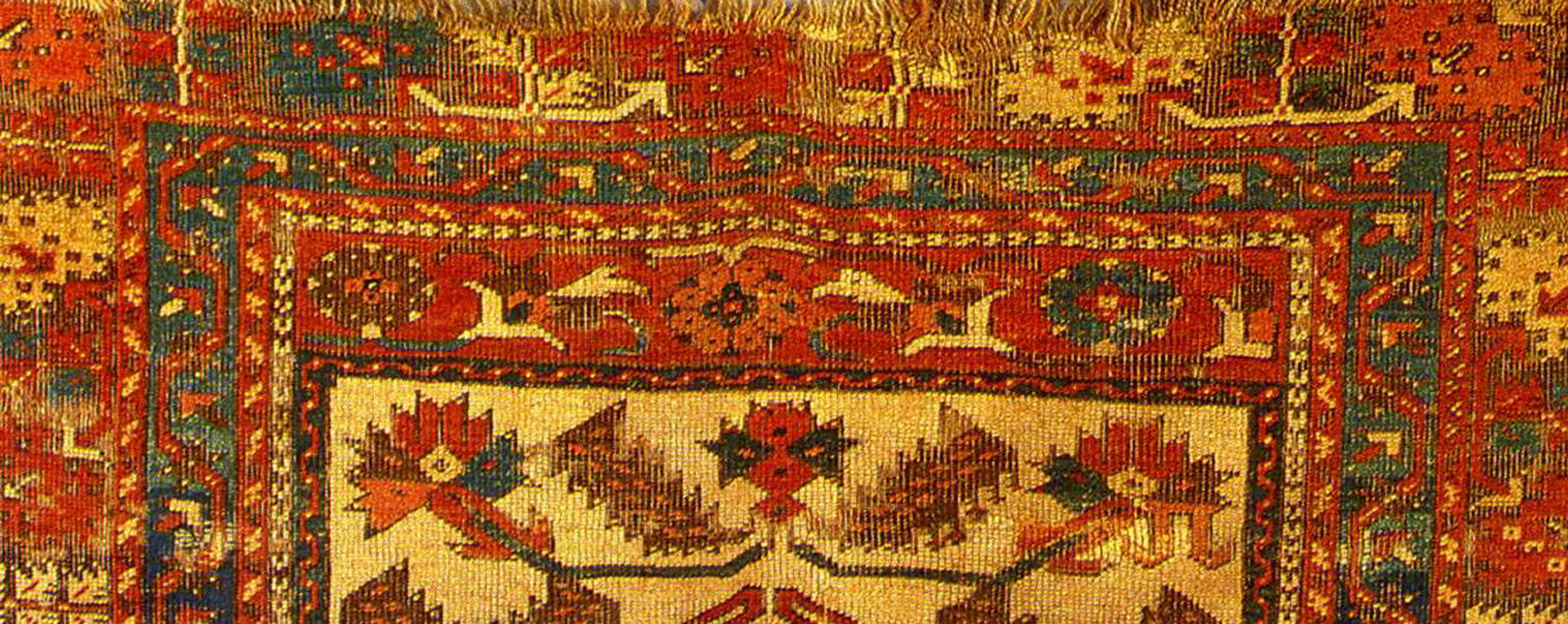 Above: a late 18th century rug woven in Anatolia, showing signs of fraying at the top as the ends begin to deteriorate
Above: a late 18th century rug woven in Anatolia, showing signs of fraying at the top as the ends begin to deteriorate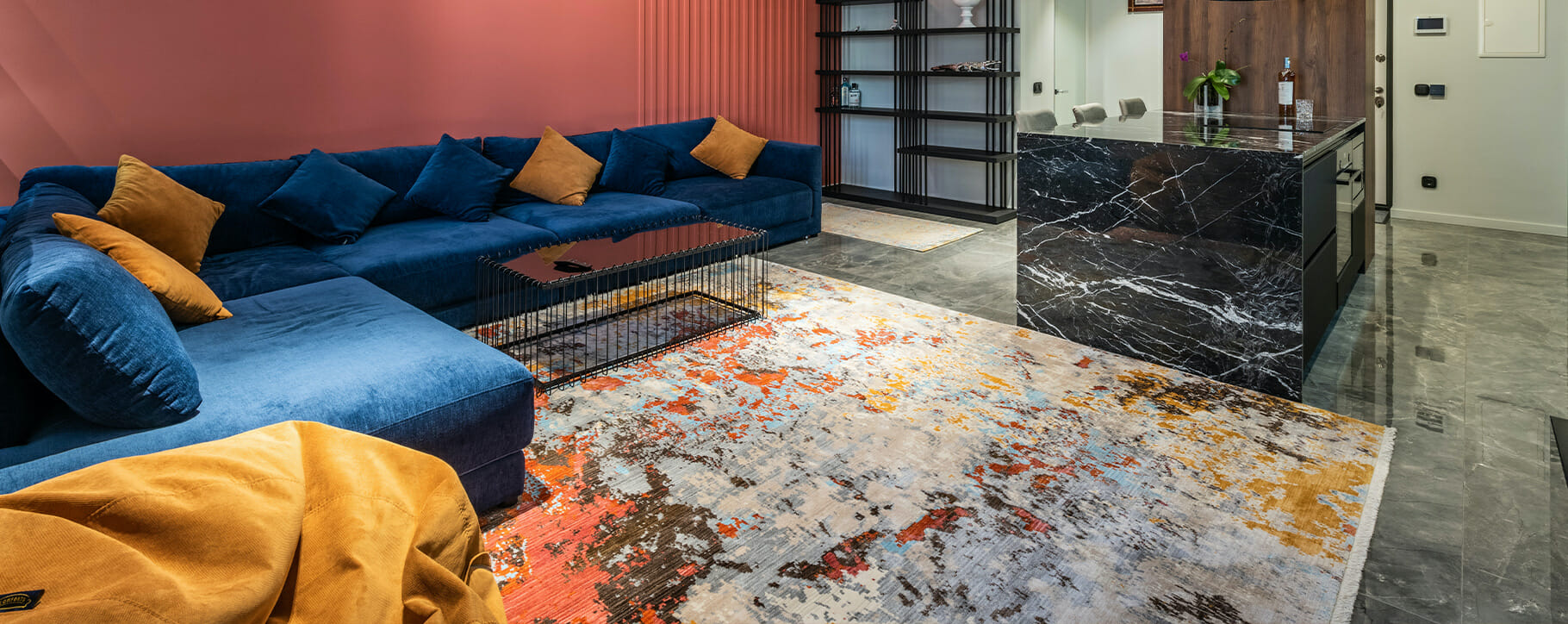 Above: a contemporary rug in a modern setting – even new rugs may face deterioration from the environment or due to their manufacturing process
Above: a contemporary rug in a modern setting – even new rugs may face deterioration from the environment or due to their manufacturing process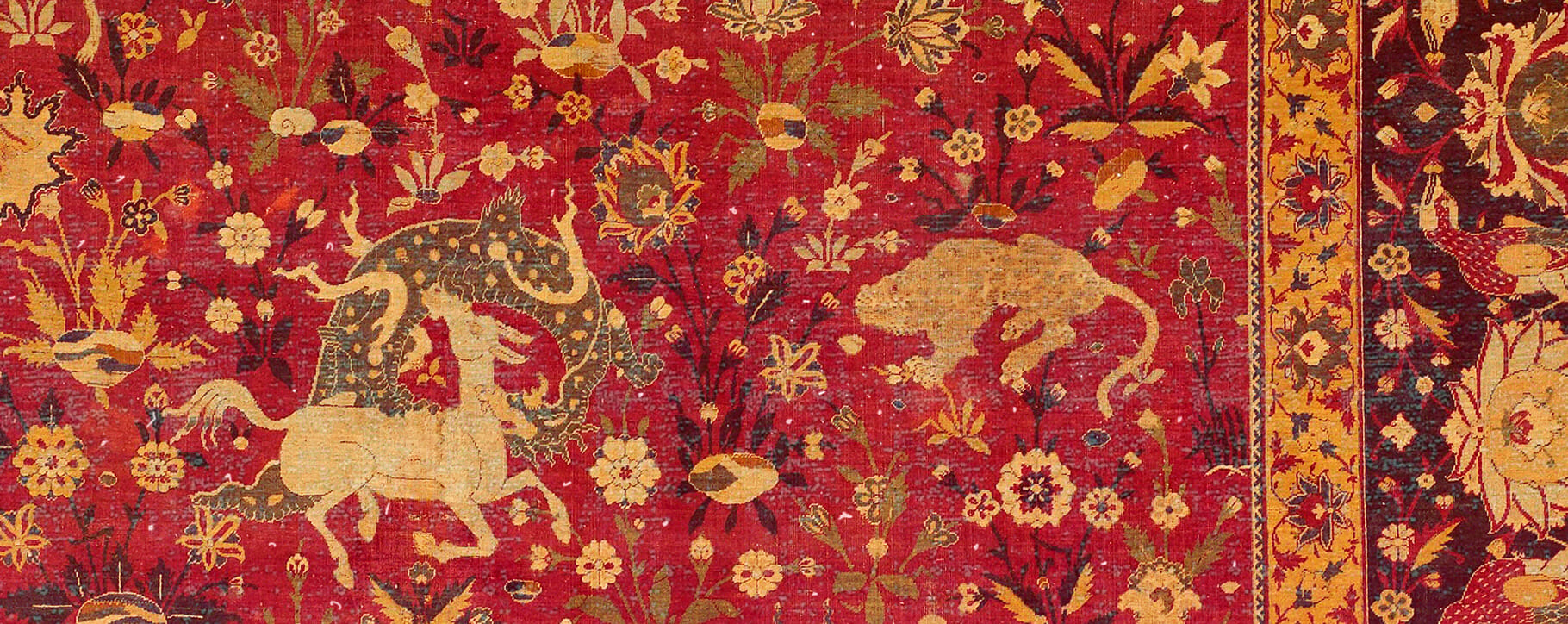 Above: an antique rug with white knots, freckles and faded dyes
Above: an antique rug with white knots, freckles and faded dyes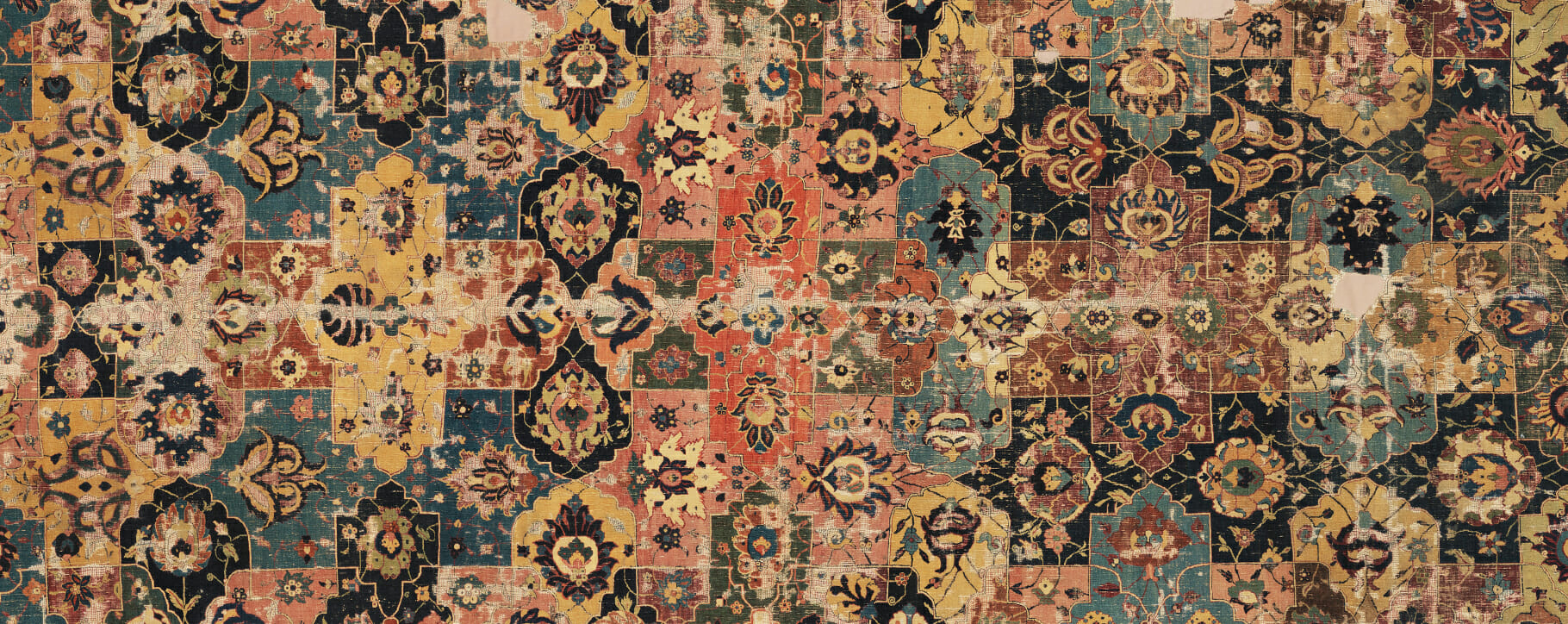 Above: an age-deteriorated carpet with a vase technique and overlapping cartouche design, handmade in Iran, 17th century
Above: an age-deteriorated carpet with a vase technique and overlapping cartouche design, handmade in Iran, 17th century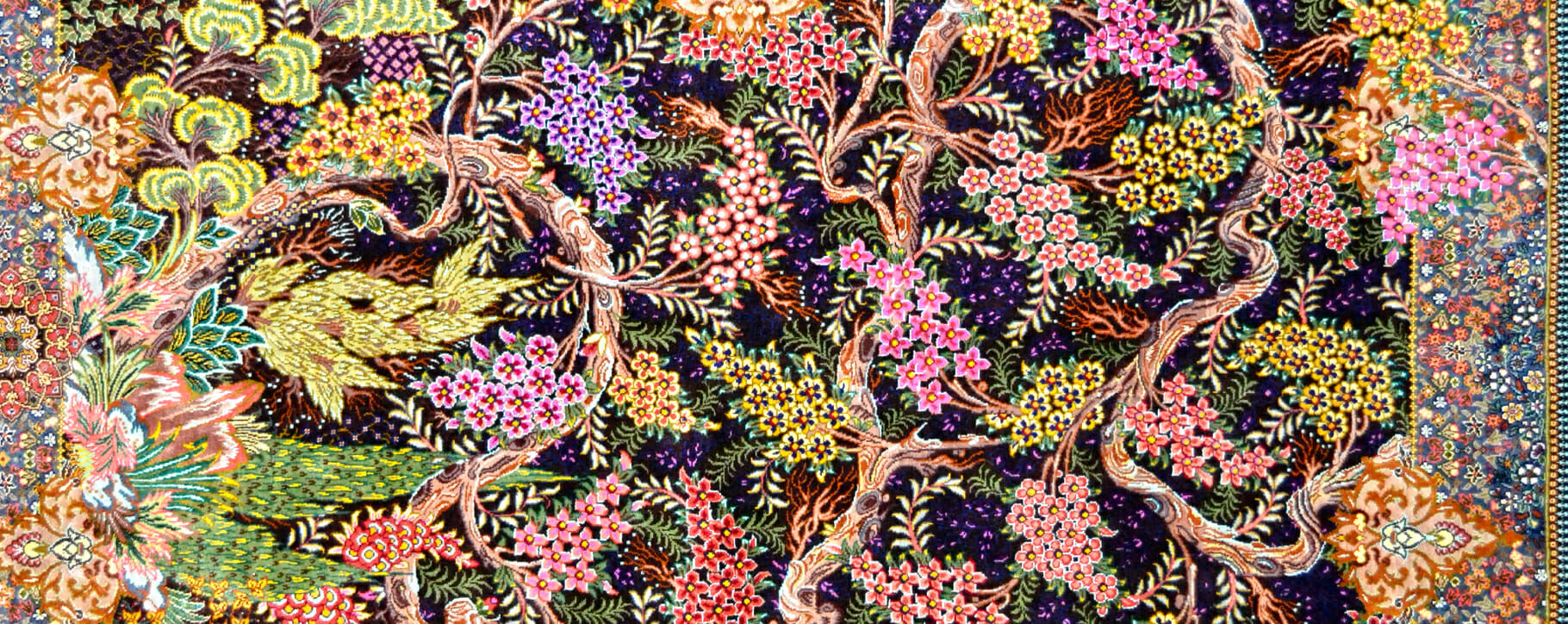 Above: a brightly coloured rug with detailed floral patterns
Above: a brightly coloured rug with detailed floral patterns Above: a new rug with light areas which may be at high risk of visual disturbance from staining
Above: a new rug with light areas which may be at high risk of visual disturbance from staining




